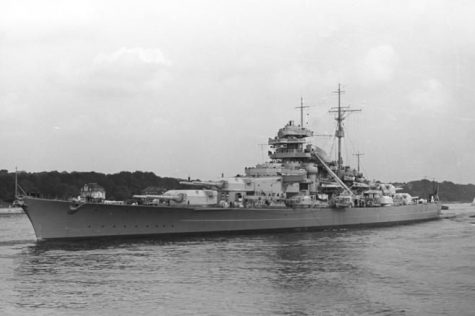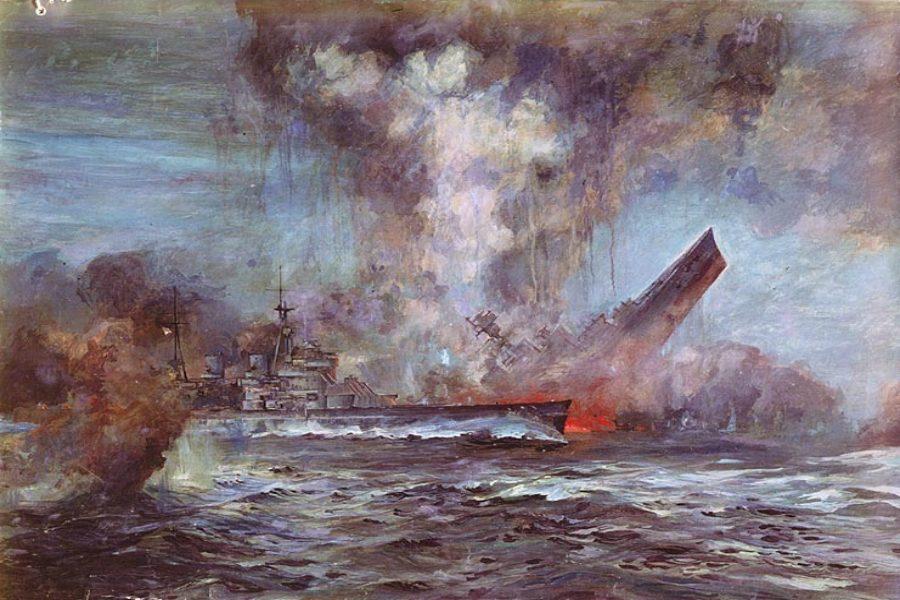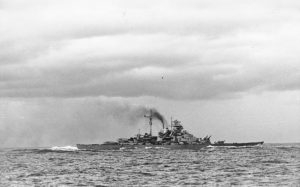Hunt for the Bismarck 75th Anniversary Series: The Battle of the Denmark Strait
IMAGE / J.C. Schmitz-Westerholt
J.C. Schmitz-Westerholt painted “Sinking of H.M.S. Hood.”
This is part one in a three-part series.
75 years ago, the forces of the British Royal Navy and the German Kriegsmarine faced off in the Denmark Strait, triggering one of the most famous manhunts of all time: the hunt for the Nazi battleship “Bismarck.”
The Royal Navy, represented by the battleship HMS Prince of Wales and the pride of the Royal Navy, battle cruiser HMS Hood, fought against the Nazi battleship Bismarck and heavy cruiser Prinz Eugen.
Bismarck, the flagship of the German Kriegsmarine, was launched in 1939. The battleship weighed 41,700 tons — more than any European ship ever built — and was outfitted with 15-inch naval guns.

Prinz Eugen in 1946, after being handed over to the U.S. Navy.
On May 18, 1941, Bismarck, along with the heavy cruiser Prinz Eugen, disembarked on Operation Rheinübung and sailed into the North Atlantic.
Their objective was to sink Allied merchant ships, and disrupt trade between the Allies and Great Britain.
However, Swedish ships spotted the two large warships steaming for the Atlantic shipping lanes and alerted the British Admiralty on May 21.
The Admiralty dispatched HMS Hood and HMS Prince of Wales to the Denmark Straits, where the two large vessels were last reported to be.
On the morning of May 24, Hood and Prince of Wales made contact with the German ships.
Vice Admiral Lancelot Holland, aboard Hood, gave the orders to fire on the two ships, and Hood fired the first shots at 5:52 a.m. with its shells missing Bismarck and Prinz Eugen.

The HMS Hood, photographed in 1921.
Adm. Günther Lütjens, commander of the operation aboard Bismarck, gave orders to hold fire, refusing repeated attempts from Bismarck’s officers to allow Bismarck’s guns to fire.
Finally, after growing frustrated with Lütjens’ orders, Ernst Lindemann, captain of the Bismarck, said to Lütjens, “I’m not letting my ship get shot out from under my a–. Open fire!”
Bismarck finally began firing with Prinz Eugen following. A shell from one of the ships struck Hood, causing a large fire on deck, with another shell hitting Hood’s main mast.
Finally, at around 6 a.m., crewmen on board the Prince of Wales watched in horror as a large jet of fire shot up from the Hood’s midsection.
The Hood’s hull buckled suddenly and it blew up. The forward section of Hood’s wreckage sank fast. Men found themselves in a sea of burning oil.
Ted Briggs, a signalman in the compass platform, the highest point of Hood’s bridge, recounted the sinking.
“There was no order to abandon ship, nor was a word uttered,” Briggs said in his book, “Flagship Hood, the Fate of Britain’s Mightiest Warship.” “It just was not required. The Hood was finished, and no one needed to be told that.”
Briggs raced to the door of the compass platform, where an officer stepped aside and let Briggs out first, saving his life. Briggs jumped into the cold water and burning oil, where he watched the Hood slip under the waves.
Hood went down, with its bow sticking up toward the sky. Hood’s forward gun turret, being manned in a futile effort by the surviving gunnery crew trapped in the forward turret, fired a final salvo before the ship finally disappeared.

The HMS Prince of Wales, photographed in 1941.
Briggs, along with Midshipman William Dundas and Able Seaman Robert Tilburn, survived the explosion. The lives of 1,418 officers and sailors, including Vice Adm. Lancelot Holland and Capt. Ralph Kerr, were lost with the ship.
Briggs died in 2008, aged 85. He was the last survivor of the sinking.
With Hood gone, the Bismarck and Prinz Eugen concentrated their fire on Prince of Wales. The men on the Prince of Wales scrambled to return fire, but with the ship’s guns malfunctioning, Prince of Wales’ efforts proved futile.
On board Prince of Wales, Capt. John Leach, realizing that further engagement with the German ships along with Prince of Wales’ gun malfunctions could result in the loss of his own ship, decided to break off the battle and steam away.
The Germans on board Bismarck and Prinz Eugen celebrated the sinking of Hood.

Bismarck in 1940.
On the Bismarck, Capt. Lindemann requested Adm. Lütjens to pursue and sink Prince of Wales. Lütjens refused the request, and ordered Bismarck and Prinz Eugen to sail to the open waters of the North Atlantic.
The British were shocked by the sudden loss of Hood. The flagship of the Royal Navy symbolized Great Britain’s might and sea power. Nobody expected the ship to be lost so suddenly.
Angered by Hood’s sudden loss, the Admiralty dispatched every available British warship in the Atlantic with only one objective: find the Bismarck and send it to the bottom.

Senior
Birthday: April 8, 1999
Extracurricular activities: Robotics, quiz bowl
Hobbies: WWI, WWII, and Civil War reenacting; marching band
...








